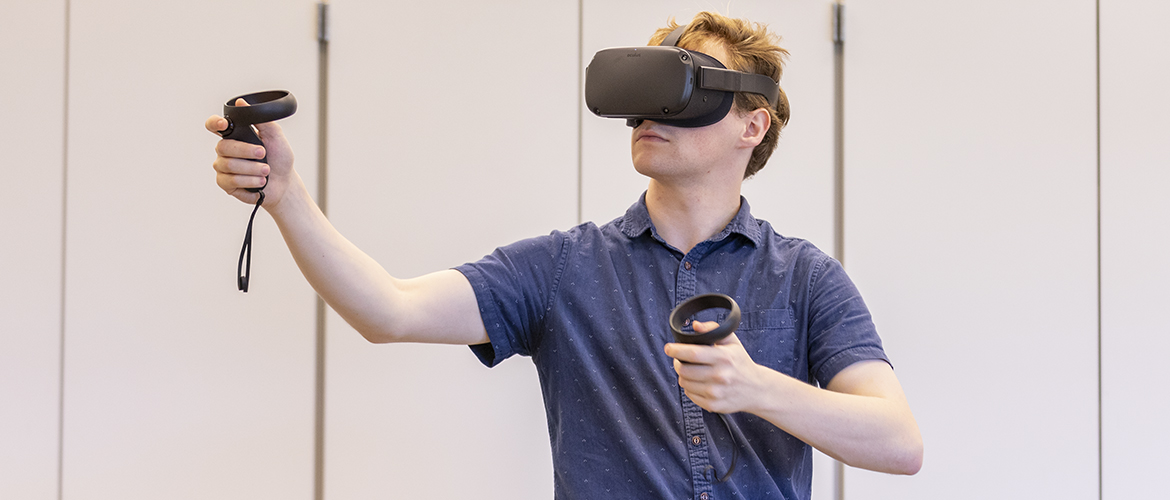In a recent undergraduate physics lab, students donned immersive headsets and held controllers in both hands to conduct an experiment in virtual reality (VR). As they manipulated objects in the virtual world, physics doctoral student Jared Canright bounced around the room, answering questions and addressing glitches. For the undergraduates, the VR experience was a novel way to learn a challenging physics concept. For Canright, it was an important step in his graduate research.
Canright is intrigued by the potential for using virtual reality in physics education. While some physics concepts — gravity, for example — are readily experienced in the real world, others are far more difficult to demonstrate. He believes VR may provide a way to observe those less tangible concepts.

“Physics is essentially just how the world works — how things fall, how things move, how things heat up and cool down, how things are attracted and push away from each other,” Canright explains. “The further you get into the physics curriculum, the less able you are to readily experience those phenomena. That can be frustrating for students. It was frustrating for me as a physics undergraduate. By creating virtual worlds, we can slow the speed of light or remove friction or gravity. We can create opportunities to examine phenomena in isolation.”
While the use of virtual reality in educational settings is growing, only a handful of researchers are working on VR specifically for physics education. Canright believes he may be the first to use fully immersive VR headsets as equipment in an introductory university physics laboratory. He chose electromagnetism, one of the fundamental forces of nature, as the focus of his first VR project. The VR activity explains Gauss’s law, a theorem concerning the distribution of electric charge to the electric field that results from that charge. It’s a pivotal concept in introductory physics, and one that can be challenging to teach, since it involves electric flux — the measure of the electric field through a given surface — which is difficult for students to visualize.

Using VR, Canright created a visualization of Gauss’s law that uses arrows and lines to indicate electric fields and transparent three-dimensional shapes to demonstrate electric flux. As students move the 3D shapes over various electric fields, the color of the shape changes in response to the sign and magnitude of electric flux through them. “It’s a very responsive visualization,” says Canright. “I’m hoping that this visualization of flux can both enhance the ability to answer questions about Gauss’s law and demonstrate that VR technologies can have a niche in physics education.”
We need to understand what content is best taught in VR, and that’s what this research is all about.
Fellowship support has been essential for Canright’s work. A National Science Foundation Graduate Research Fellowship provides support comparable to a research assistant or teaching assistant position, and an Achievement Rewards for College Scientists (ARCS) Fellowship provides funding for equipment and for travel to conferences. A small seed fellowship from the American Association of Physics Teachers funded Canright’s startup costs.
“I owe everything to fellowship support,” Canright says. “It has made the entire project possible. This is not an established field of research, so it’s difficult to find grant funding. That’s made the fellowship support absolutely invaluable.”

Canright owns one Oculus Quest VR headset — “basically a game console like a PlayStation or Xbox, but to learn physics” — and borrowed ten more from the CoMotion MakerSpace to bring his VR activity to the undergraduate physics lab. The 22 students in the lab worked in pairs, with one wearing the headset while the other read the lab manual and took notes. With funding from the UW Student Technology Fee, 30 more VR headsets will soon be available through CoMotion. That will enable Canright to test his VR experiments with larger classes. He hopes to develop a larger trial over the next few months.
Looking ahead, Canright plans to continue exploring the potential of virtual reality in physics education. He believes it’s a field full of possibilities.
“The technology is only getting better,” he says. “We can assume that this technology will become commonplace and fairly accessible in the next decade or two. But before VR has a major role in the classroom, the big challenge will be identifying exactly how it should be used. VR should not be used as a fun gimmick. We need to understand what content is best taught in VR, and that’s what this research is all about.”
More Stories

Democracy by the Numbers
Mathematics and Democracy, an undergraduate mathematics course, explores the role of math in many aspects of democracy, from elections to proportional representation.

A Statistician Weighs in on AI
Statistics professor Zaid Harchaoui, working at the intersection of statistics and computing, explores what AI models do well, where they fall short, and why.

The Mystery of Sugar — in Cellular Processes
Nick Riley's chemistry research aims to understand cellular processes involving sugars, which could one day lead to advances in treating a range of diseases.